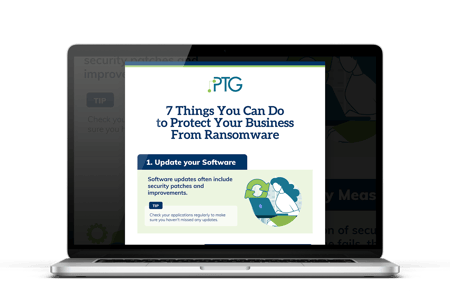Bank failures are not uncommon, but they can create a ripple effect on the economy and on individuals’ financial well-being. Recently, two large banks failed, and a third bank is on the brink of failure. These failures are not only concerning for the customers of these banks but also for other financial institutions and businesses that may become targets for scams and phishing attacks. In today’s post, we discuss the threat of downstream scams and phishing and provide tips on how to protect your business amidst this global event.
The Threat of Scams and Phishing
Scammers and hackers are always looking for opportunities to steal sensitive information, such as bank account numbers, passwords, and social security numbers, to commit fraud and identity theft. The recent banking failures provide an ideal opportunity for scammers to prey on the fears and vulnerabilities of customers of these banks and other financial institutions. They may send phishing emails or text messages that appear to be from the banks or the Federal Deposit Insurance Corporation (FDIC), asking customers to provide personal or account information or click on a link that leads to a fraudulent website.
Protecting Your Business from Scams and Phishing
While it may be challenging to prevent all scams and phishing attempts, there are some general best practices and tips that you can follow to reduce the risk of falling victim to these attacks:
Verify the Sender
One of the most critical things you can do to protect your business is to verify the sender of any email or text message that asks for personal or account information. Be cautious of any message that appears to be urgent, threatening, or too good to be true. Fraudulent messages often contain grammatical errors, misspellings, and suspicious links. If you are unsure about the legitimacy of a message, contact the bank or financial institution directly using a phone number or email address that you know to be valid.
More on business email compromise: How to Protect Your Business From This $43B Scam
Use Secure Channels
When communicating with your bank or financial institution, use secure channels, such as the FDIC Claims Portal or the bank’s secure website. Avoid using public Wi-Fi or unsecured networks when accessing sensitive information. Set up multi-factor authentication, such as a password and a code sent to your phone, to add an extra layer of protection to your accounts.
Download Your Free Ransomware Tips Infographic Here
Protect Your Passwords
Passwords are a common target for hackers, so it’s essential to use strong and unique passwords for each account. Avoid using the same password for multiple accounts, and do not share your passwords with anyone. Change your passwords regularly and consider using a password manager to generate and store complex passwords.
Should you use a password manager? Top 5 Reasons Small Businesses Should Use a Password Manager
Monitor Your Accounts
Regularly monitoring your bank and financial accounts is a crucial step in detecting any unauthorized activity or suspicious transactions. Check your account balances and transaction history frequently, and report any suspicious activity to your bank or financial institution immediately.
What To Do If You Think You’re Compromised
If you suspect that your account has been compromised, taking immediate action is crucial to minimize the damage. If you are looking for a deeper dive, this is for you. Here are some additional steps you can take:
-
Alert Your Bank or Financial Institution: Contact your bank or financial institution as soon as possible. They can help you secure your account and prevent further unauthorized transactions. You can typically find their contact information on their website, or on the back of your debit or credit card. Be sure to ask them to put a hold on any suspicious or fraudulent activity.
- Contact Your Internal IT Department: There’s no better alternative than having a dedicated team that has experienced these situations first-hand. Even if you’re simply wary of an odd occurrence on the network or notice something specifically suspicious, contacting your IT team immediately can help prevent further security issues – they’ll know what the most immediate next steps for the network are for your situation.
-
Change Your Password: If you know which account has been compromised, change your password immediately. Ensure that your new password is strong and unique.
-
Monitor Your Accounts: Check all of your accounts associated with the compromised one for any unauthorized activity. This includes checking for any changes to account information, such as email addresses or phone numbers. If you notice any suspicious activity, contact your bank or financial institution immediately.
-
File a Complaint: Report the incident to the Federal Trade Commission (FTC) at www.identitytheft.gov. This site will provide you with a personalized recovery plan to help you recover from identity theft. Filing a report with the FTC can also help law enforcement officials track down and prosecute the individuals responsible for the fraud.
-
Consider Credit Monitoring Services: Consider signing up for credit monitoring services. These services can alert you to any changes in your credit report, which could indicate identity theft or fraud. Some banks and financial institutions offer credit monitoring services for free to their customers. Alternatively, you can purchase credit monitoring services from third-party providers.
Remember, the key to protecting yourself from fraud and phishing is to be proactive and stay vigilant. Regularly check your accounts and take appropriate action immediately if you suspect that your account has been compromised. By doing so, you can prevent further damage and minimize the impact of fraud on your finances.
Conclusion
Banking failures can increase the risk of scams and phishing attacks, but there are steps you can take to protect your business. Be vigilant, verify the sender of any message, use secure channels, protect your passwords, and monitor your accounts regularly. By following these best practices, you can reduce the risk of falling victim to scams and phishing attacks and protect your business and personal information.
About PTG
Palmetto Technology Group (PTG) is an award-winning IT support and managed service provider headquartered in Greenville, South Carolina. We believe in delivering phenomenal IT experiences by people you’ll love.
As a trusted partner, our goal is to help business owners lower their risk, secure their data, and promote productive employees. To learn more, book a meeting with one of our solutions specialists here.
Cover Photo by Robert Bye on Unsplash

